
Prof Mason
Liverpool Foot and Ankle Clinic
To book an appointment, either email or phone the number below or click the link.
E-mail: CVDWclerical@outlook.com
Contact Patient Liaison: 07717580737
Ankle Arthritis
Ankle arthritis occurs when the smooth cartilage that cushions the ankle joint wears away. This causes the bones to rub together, leading to pain, stiffness, swelling, and reduced movement. It can make everyday activities like walking, climbing stairs, or standing for long periods difficult and painful.
Unlike the hip or knee, where wear-and-tear arthritis (osteoarthritis) is most common, ankle arthritis often develops after an injury, such as a fracture or repeated sprains.
What causes ankle arthritis?
Several factors may lead to arthritis in the ankle joint, including:
- Post-traumatic arthritis: The most common cause, typically following a broken ankle, dislocation, or repeated sprains.
- Osteoarthritis: Age-related wear of the cartilage, less common in the ankle than other joints.
- Inflammatory arthritis: Conditions such as rheumatoid arthritis or psoriatic arthritis can inflame and damage the ankle joint.
- Avascular necrosis: Poor blood supply to the bone, especially the talus, leading to joint collapse.
- Foot deformity: Conditions like flat feet or high-arched feet can cause abnormal joint stresses.
Symptoms
The symptoms of ankle arthritis can vary in severity but generally progress over time. Common symptoms include:
Pain
- Aching or sharp pain in the ankle, especially during or after activity
- Pain may be constant or come and go
- Often worse with walking, standing, or going up/down slopes
- Often worse on startup (e.g. standing form sitting)
Stiffness
- Difficulty moving the ankle, particularly after periods of rest (e.g., in the morning)
- Reduced ability to flex or extend the foot
Swelling
- Swelling around the ankle joint that may worsen with activity or at the end of the day
Instability or Weakness
- The ankle may feel like it could “give way”
- You may struggle with uneven ground or lose confidence in your footing
Grinding or Catching Sensation
- A feeling of grinding, clicking, or catching within the joint during movement
Deformity
- In more advanced cases, the ankle may appear crooked or misaligned due to joint degeneration
These symptoms may initially be mild and only present during high-impact activity. Over time, however, they can interfere with everyday tasks like walking, climbing stairs, or standing for long periods. If you're experiencing any of these symptoms, a specialist assessment can help determine the underlying cause and appropriate treatment.
What are the treatments for ankle arthritis?
Treatment is tailored to your symptoms, lifestyle, and stage of arthritis. At Liverpool Foot and Ankle, we provide both non-surgical and surgical options:
Non-Surgical Treatments
- Pain relief: Medications such as anti-inflammatories and paracetamol.
- Footwear modification: Supportive or rocker-soled shoes.
- Custom orthotics: Insoles or ankle braces to reduce joint loading.
- Physiotherapy: To maintain strength and motion.
- Steroid injections: May offer temporary pain relief and reduce inflammation.
Surgical Treatments
If symptoms persist, surgical options include:
- Arthroscopic debridement: Keyhole surgery to clean the joint is possible in the early stages of arthritis. This often includes removal of bone on the front of the ankle, called a cheilectomy.
- Osteotomy: Realignment surgery to offload damaged areas. This may be performed above the ankle (supramalleolar osteotomy) or at the calcaneum.
- Ankle Distraction Arthroesis: Use of a cage (external fixator) to distract the joint, promoting formation of scar tissue in the joint.
- Ankle fusion (arthrodesis): Fusing the bones to eliminate pain by stopping movement in the joint.
- Total ankle replacement (TAR): Replacing the joint with a prosthesis to maintain movement.
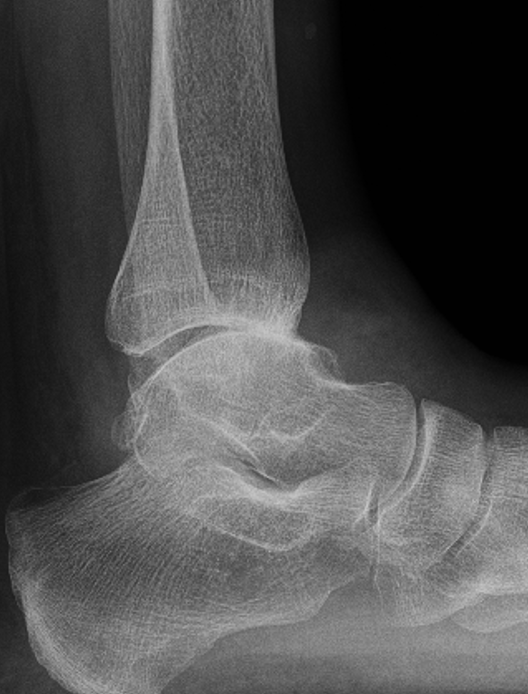
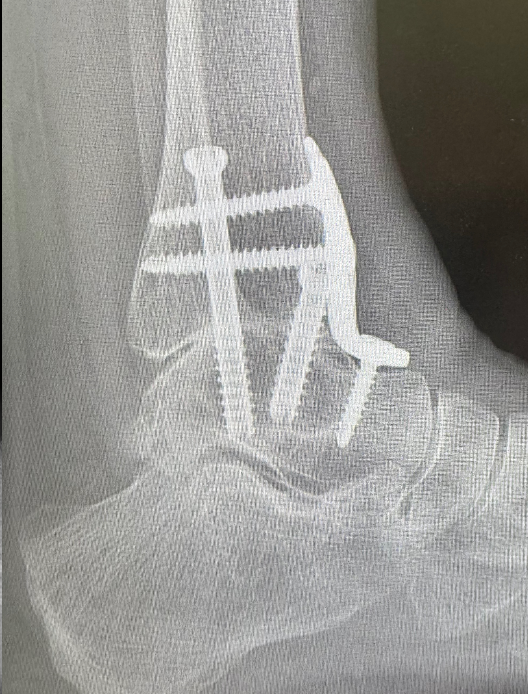
Ankle Arthrodesis (Fusion)
This is an example of an ankle arthrodesis
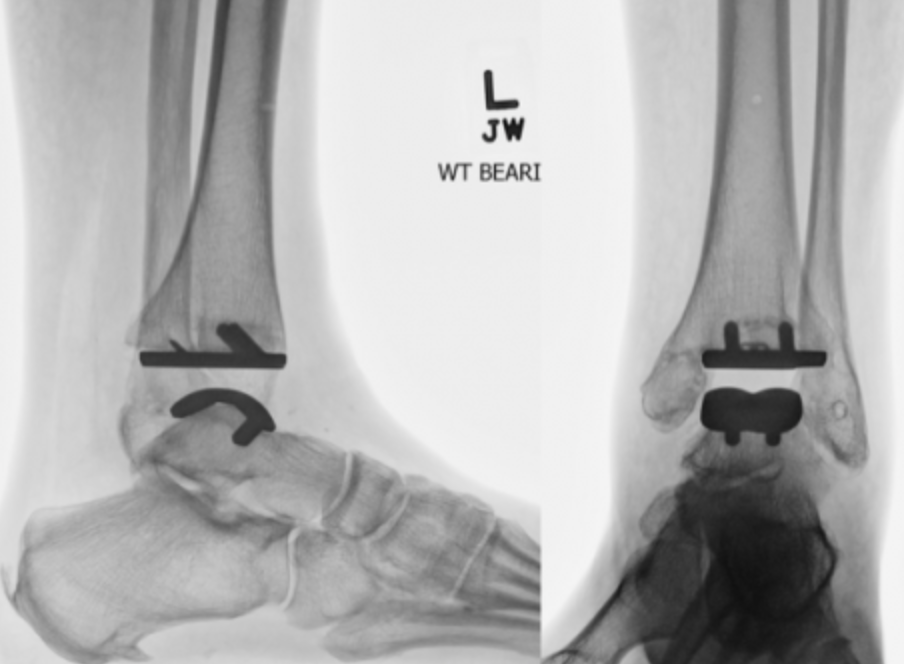
Total Ankle Replacement
This is an example of a total ankle replacement from FootEducation. For further information, use link.
What are the differences between ankle fusion (arthrodesis) and ankle fusion?
| Feature | Ankle fusion | Total Ankle Replacement |
|---|---|---|
| Pain Relief | Excellent; removes painful movement | Excellent, assuming implant is well aligned |
| Movement | No ankle motion post-op, but can maintain some movement at midfoot joints | Preserves ankle movement, more natural gait |
| Function | High satisfaction on flat ground; limited incline walking | Higher function on uneven ground/inclines |
| Impact on other joints | Can increase stress on nearby joints resulting in symptomatic arthritis in 25% at 10 years although no increase in other joint fusion at 25 years | Theoretically less stress on adjacent joints due to preserved motion in ankle, although no difference in other joint fusion at 25 years |
| Durability | Permanent if solid fusion occurs | In time TAR will wear out. Revision rates at 10 years are estimated to be between 10 and 20% Modern implants last 10–15+ years |
| Need for further surgery | 10–15% may need hardware removal; ~5–10% need revision. in 25 year study 30% had another intervention although most were removal of metal or injection. | 20–25% may need minor or major revision at 5–10 years. In 25 year study, 35% need another intervention which were more serious than in fusion patients. |
| Complexity of revision | Easier to revise | Significantly more complex |
| Best for ... | Young, very active patients; poor bone quality; large deformity | Patients with good bone and joint alignment who wish to maintain motion |
Download leaflet
click link to download leaflet comparing ankle replacement and fusion based on a 25 year follow up study using hospital coding data.
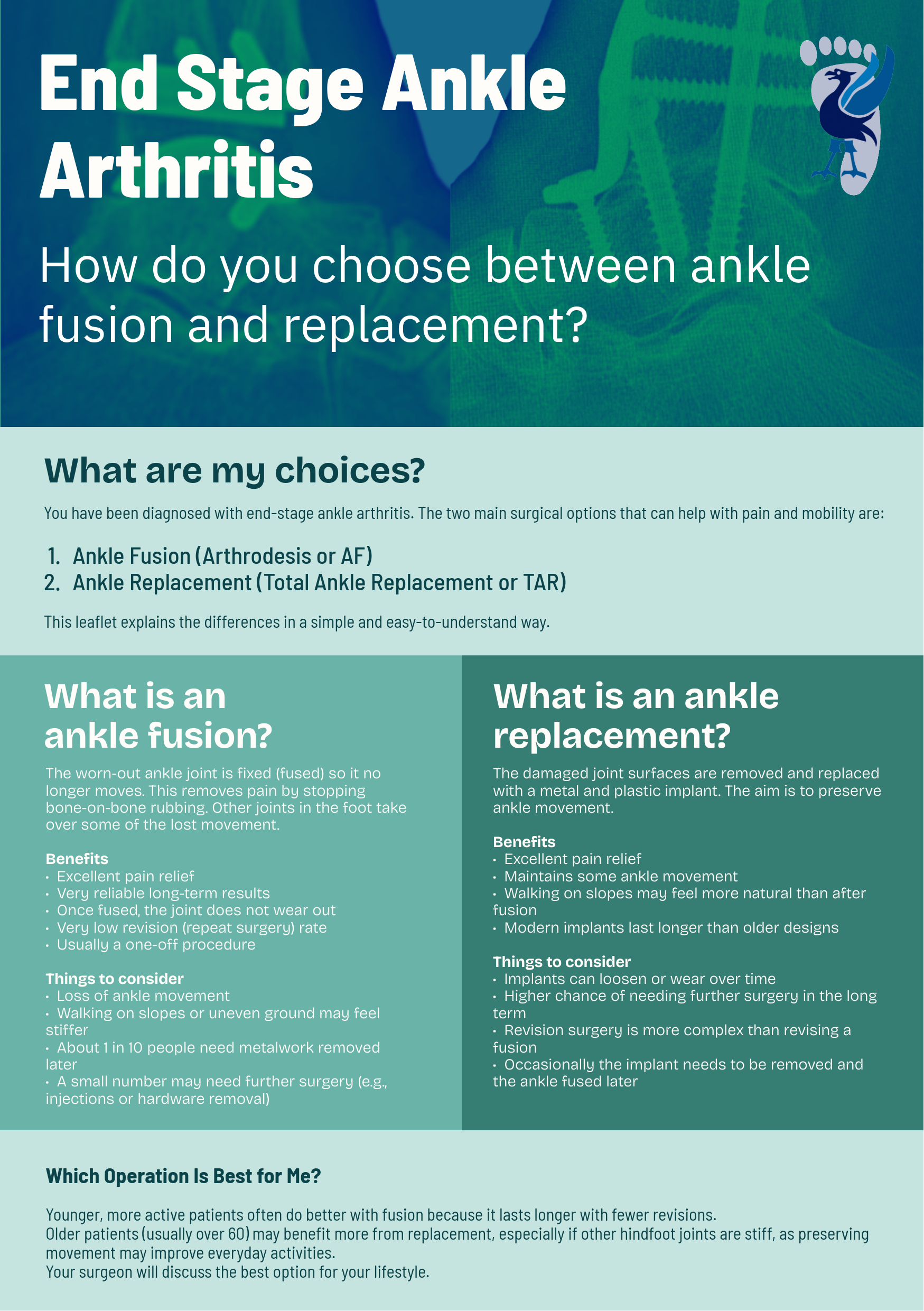
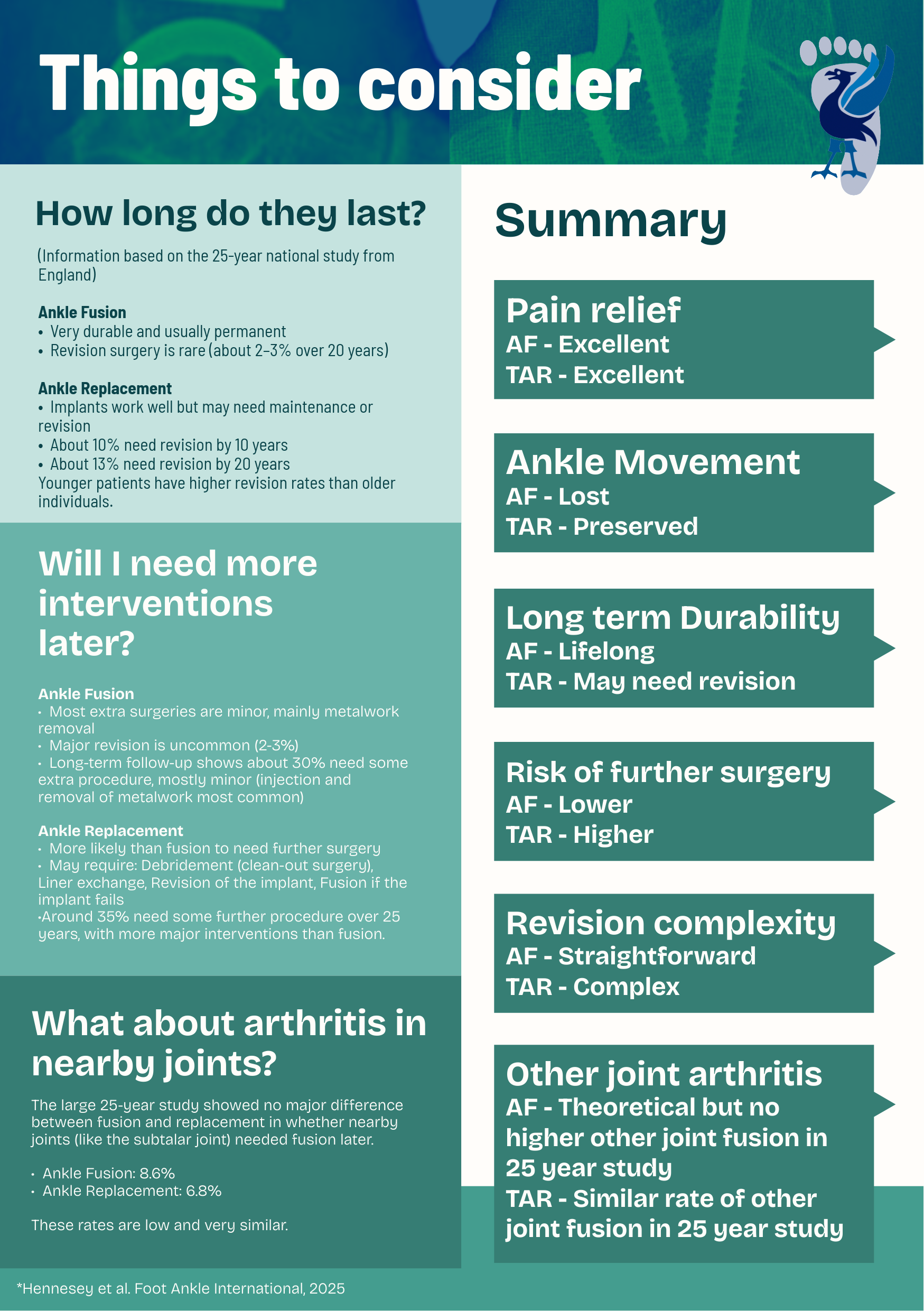
FAQs
Will I be able to move my ankle if I had an ankle fusion?
If you’ve had an ankle fusion (arthrodesis), the ankle joint itself is permanently stiffened, meaning:
You will not be able to move your ankle up and down at the tibiotalar joint, which is the main ankle joint affected by arthritis or injury and the one fused during the operation.
However, that doesn't mean your whole foot is stiff. Most people can still:
Move the joints below the ankle, such as the subtalar joint, which allows some side-to-side and uneven surface walking motion.
Push off with the foot while walking, thanks to preserved motion in the midfoot and forefoot joints.
Walk, cycle, drive, and even run short distances if the surrounding joints are healthy and you undergo proper rehabilitation.
In short:
❌ No movement at the fused ankle joint
✅ Retained movement below and around the ankle
✅ Most patients return to normal daily activities, but high-impact sports are limited
Is there any difference in return to sport following either ankle replacement or ankle fusion?
Based on the study "Total ankle arthroplasty versus ankle arthrodesis: Comparison of sports, recreational activities and functional outcome" (International Orthopaedics, 2012), the difference in sports and recreational activity between ankle fusion (arthrodesis, AAD) and ankle replacement (TAR) is minimal.
🔍 Key Findings:
- Post-operative activity:
Both groups had 76% still active in sports and recreational activities
The drop in activity post-surgery was not statistically significant
AOFAS Hindfoot Score (functional outcome):
Identical in both groups: 75.6
Ankle Activity Score:
Decreased in both groups (p = 0.047), but not differently between them
✅ Conclusion for Patients:
There is no significant difference in return to sports or recreational activities between ankle fusion and ankle replacement.
Both procedures allow patients to remain active, although activity levels may slightly decrease after surgery in either case.

